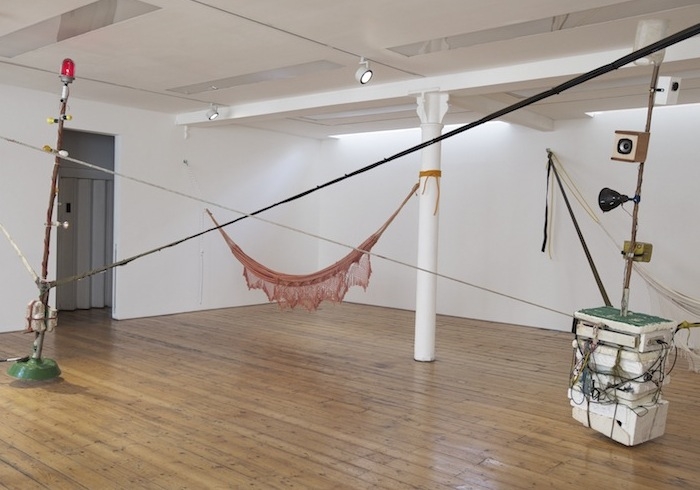Sprovieri, London, 30 June – 22 September
Nothing touches the floor in this exhibition of work by Brazilian artist-collective and band Chelpa Ferro. Nothing except my own feet.
A web of coloured climbing ropes and straps – of the sort that you might find tying down a tarpaulin covering the bed of a truck – criss-cross the room, joined to one another and connected to the walls around them by big, heavy-duty aluminium clips or steel hooks.
This web supports three hammocks – two white and one a deep, salmony pink, in which viewers are invited to lie – as well as two totem-pole-like constructions made up of old wooden posts, timber offcuts, a used frying pan, lumps of brick, breezeblock and polystyrene, a single hammer, rusted scaffold poles and an empty, inverted oil carton. These modules float or hover just above the ground, functioning to pull the entire web of strapping taut. One pole is festooned with coloured lightbulbs dotted up its length and crowned by a red beacon. The other holds an assortment of old speakers: some megaphone-esque, others home hi-fi or Tannoy-style, all connected via a rainbow of cables to an amplifier, which is in turn strapped to a polystyrene block with some old wire.
As you might expect, the pole of lights illuminates at various intervals and rhythms, sometimes one bulb at a time, sometimes in sequence, climbing up the pole, and sometimes in concert, flashing or holding their luminescence in unison with the sound that the speaker-pole is emitting. This nonmelodic noise consists of a mixture of low rumbles, urgent knocking, high-pitched tinkering and pulsating taps, and creates a discordant mood in the whole space. The sense is that you have stumbled across a communication network for somebody whose language you don’t know – somebody distant in time and place whose messages are being transmitted into the gallery by these modules made of previously unwanted materials. The work seems to layer histories or times, as the title suggests – an old junkyard assemblage meets a futuristic floating invention. It is simultaneously postapocalyptic (I am strangely – embarrassingly – reminded of the floating towns and communities from the 1995 Kevin Costner film Waterworld) and utopian in its celebration of salvage and recycling, making us increasingly aware of the objects we discard.
Chelpa Ferro, which roughly translates as ‘old money’, consists of sculptor Barrão, painter Luiz Zerbini and film editor Sergio Mekler. The trio formed in Rio de Janeiro in 1995 as a band making improvised music using debris and objects found in the street, as well as traditional musical instruments, which they then translated into installations or works of art in a gallery setting. By incorporating discarded materials into the resulting complex audiovisual networks, Chelpa Ferro gives these items a new purpose or function, resuscitated by new technologies that synchronise or connect each constituent part into a bigger whole.
Perhaps this urge to scrutinise the way that we, as a society, understand commodity and excess is a little heavy-handed, but the reminder that objects persist once we are done with them is certainly welcome. As viewers, it feels as though we (and our own consumption/waste decisions) are implicated in this sonic, radiant web of superfluity. The atmosphere of the room feels charged, as though you might get an electric shock if you touch something; or, because you are the only ‘thing’ touching the floor, that you are somehow earthing the entire situation. This feels grounding, and reinforces your connection to the mesh of reinvigorated debris around you, allowing the layering of histories and times – apocalyptic futures or old-fashioned junkyard invention – to communicate with your today.
First published in the September 2017 issue of ArtReview
